Near Palenque, Chiapas, Mexico.
Travel & Tour
Pictures, Photos, Information, Images, & Reviews.
George & Eve DeLange
Google Map To Palenque Archaeological Ruins
Near Palenque, Chiapas, Mexico.
View Larger Map
We Are Proud Of Our SafeSurf Rating!
Click On Any Of The Following Links By Amazon.Com
For Books Or Videos About Palenque. No Obligation!

Palenque Site Map.
Courtesy Of Andrew Coe's "Archeological Mexico."
 |
| Palenque Site Map. Courtesy Of Andrew Coe's "Archeological Mexico." |
|---|
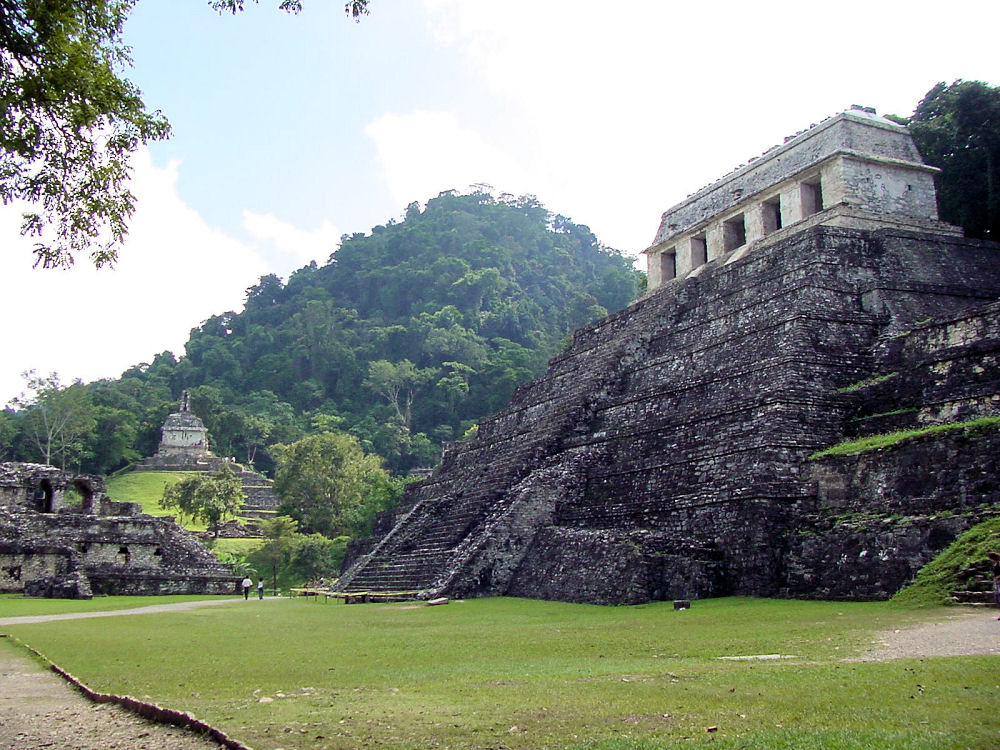 |
| "Temple Of The Inscriptions". Location Of The Tomb Of K'inich Janaab' Pakal I, Known As "Pakal The Great". |
|---|
| "Temple Of The Inscriptions", Photo Taken From North West Corner Of "The Palace" Compare The 2004 Photo To The 1988 Photo Below. |
|---|
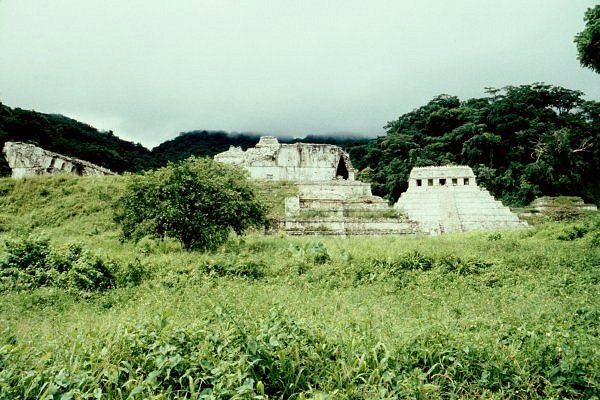 |
| "Temple Of The Inscriptions", Photo Taken From North West Corner Of "The Palace" Compare The 1988 Photo To The 2004 Photo Above. |
|---|
Palenque Archaeological Ruins:
A Spanish word for "fortification". An ancient name for the city was Lakam Ha, which translates as "Great Water", for the springs and small rivers which flow from the site. Palenque was the capital of the important classic-age Mayan city-state of B'aakal (Bone). Our GPS location at the North Group was about 17o 29' 12" N 92o 02' 44" W. Palenque is located at the edge of the jungle overlooking the flood plain of the Rio Usumacinta, Palenque is definitely one of the most beautiful sites in all of Mesoamerica. Probably the richest and most elaborate tomb ever discovered in Mexico is located in the Temple Of Inscriptions at Palenque. This beautiful ruined city is set among the steep foothills and dense jungles at the base of the Chiapas Highlands. We could easily spend two days wandering and exploring the site and not see it all. Also, many unexplored temples lie in the dense surrounding forest. This page will show photographs during two of our visits to this beautiful Mayan ruins. We first explored the site when it was less rushed and not quite so well loved by the tourists. That was in August of 1988. We recall that we were the only people on the site for several hours. We could hear the animals in the jungle and the rustling of the waters in the nearby stream as we walked amongst the quiet temples and pyramids of Palenque. We recall our amazement when we discovered a delicious orange tree with ripe oranges on the site for our refreshment. Instead of having an orange colored skin, the oranges were green in color! But, they tasted wonderful! As it became later in the day we recall the temperature rising to a point where it became necessary to drink a lot of water and to rest under the shade of trees and in the shade of the various structures of Palenque. Our second visit was on February 1, 2004 between about 10:00am to about 4:00pm. We were quite suprised at some of the changes that we have seen. For example due to reconstruction ordered in 1992, instead of gaining access from the old parking lot, which led to the foot of the Temple of the Inscriptions, the public now leaves their vehicles at either the Museum and Service Center with offices, shops, cafe, and auditorium, where the old Hotel de las Ruinas used to stand or a little further up the hill in a commercial area near the entrance. At this highly commercial area we were even able to have our car washed and polished in the uphill parking area while we explored the ruins. One of the things for the best is that the site has been excavated and restored much more than our first visit and there are more things to see and do. Palenque is one of the jewels of Mexico that must be seen to believe. We do remember the time when you could visit Palenque and be the only people on the site and that was very nice. The town of Palenque has grown a great deal since our first visit to the area and there are more accommodations for the visitor. Parts of the ruins that are now closed to the general public were open during our first visit and we were fortunate enough to be allowed to visit some of those areas, such as Lord Pakal's Tomb. In fact, we were not permitted to set foot on the Temple Of Inscriptions this time. For those who have not been able to visit Pakal's Tomb, we will enclose our older pictures on the Pakal's Tomb Page for your enjoyment. There are not to many books which describe how to tour Palenque that are current and up to date. The best we could find is Andrew Coe's book, "Archeological Mexico." We highly recommend this book. You should read it before visiting the site and you should take the book with you as you tour the site. The first permanent settlement of Palenque may have been in about 300 A.D. Palenque was located at the northwestern border of the early Maya Chicanel culture centered in the Peten Jungle. It is thought that the early settlement center of Palenque was around the Picota Group and the Templo Olvidado located in the forest a kilometer west of the main plaza. Between A.D. 300 and 600, Palenque was a small regional center with trade ties to the Peten region and to the Chiapas Highlands and the Grijalva Valley just beyond. During this era, Palenque's center shifted from the Picota Group to the present Main Plaza area. The site shared many cultural and artistic characteristics with the centers of Piedras Negras, Yaxchilan, and Bonampak lying up the Rio Usumacinta. Therefore, it is thought that they were built by peoples araising from a common ancestry. The Usumacinta river acted as the region's main highway along which people traded not only goods but also civic and religious beliefs. Then in the middle of this time period, Palenque's written history begins. From the records on March 10, 431, a man named K'uk' B'alam (Quetzal-Jaguar) ascended to the throne. We know this from the dynastic history written two centuries later by the great Palenque ruler K'inich Kan B'alam II (Great Sun Snake-Jaguar). He traced his family history from the mythic first ruler "Lady Beastie" through to a semi - mythic king named U-Kix-Chan. From K'uk' B'alam, Kan B'alam II then recorded the following eleven generations leading up to himself, and he commissioned artists to tell the story on hieroglyphic plaques decorating the tops of Palenque's major temples. The apex of Maya civilization-begins about A.D. 600. During the next hundred years, the rulers of Palenque commissioned some of the best Maya artwork discovered. Most of the great structures you see in Palenque's central area date from this time period, including the Palace and the Temples of the Inscriptions, Count, Cross, and the Sun. These works were built during the reign�s of the two greatest Palenque rulers, K'inich Janaab' Pakal I and his oldest son, K�inich Kan B�alam II. In A.D. 603, K'inich Janaab' Pakal I, better known as "Pakal the Great", was born, and he ascended the throne twelve years later. His greatest monument was the Temple of the Inscriptions, designed as his tomb. The massive stone lid covering his body was carved with a relief showing Pakal descending into the mouth of the Underworld. In 683A.D. at the age of 80, his oldest son, K�inich Kan B�alam II, then succeeded Pakal to the throne. Palenque flourished during the next seventy years following Kan B'alam II's death in A.D. 702. The city then reached its height as a regional power and expanded far north into the present day Mexican state of Tabasco. The completion of the Temple of the Foliated Cross and an addition to the Palace was made during that time. After 731 A.D. most construction had stopped. Unfortunately, Palenque's best-known 8th-century ruler, K'inich K'an Joy Chitam II, is famous only for his defeat and capture in 711 A.D. by the new military power of Tonina. For more information please look at our Tonina page. By 810 A.D. the ritual activity in Palenque comes to an end. Then by 900 A.D. Palenque becomes deserted and the temples are reclaimed by the forest. TOURING THE SITE: First, we have never toured the entire site. We have been on the site for several hours on two different occasions but the site is just to big to see in one day. So, we have been selective in what we toured and we still have hopes of returning to the site to see the places that we have missed. We will say that we have toured the major structures that most tourists are interested in viewing. So, we will present them on this web site. From the very crowded and noisy parking lot, you go through the security check point and entrance from the West into the West side of the Main Plaza. At the base of the hill to your right you will see three temples. The first is Temple XII, known as the "Temple of the Dying Moon." Look at the left pier of the upper part of the temple and you will see the carved skeletal mask of a rabbit with large fangs. Remember that the Maya associated a rabbit with the image that we commonly call "the man in the moon". next time you look at the moon try to see the rabbit, it is there! A dead rabbit corresponded with a dying or waning moon. Looking straight across (North) of Temple XII we can see Temple XI. Next to this path lies the tomb of Alberto Ruz Lhuillier (1906-79). Continuing to the East, past Temple XII we see a smaller structure called Temple XIII where a noble tomb was discovered in June of 1994. It contained a richly dressed skeleton of a man in his 40's. The sarcophagus also contained the remains of two females, one adult and one adolescent. This structure is covered with a thatched roof. The skeletons have been removed. You can go inside and see the tomb in the very dim light. Continuing to the East you can see the beautiful "Temple of the Inscriptions." This 61 meter tall pyramid was painted a deep red. It was built during the second half of the 7th century A.D. during the last decades of Pakal the Great's reign. The staircase ascends nine tiers to the top. Two stone reliefs, flank the upper flight of stairs. The upper temple is a wide structure with a ruined roofcomb. Five doorways enter into one large room containing stucco reliefs decorating both sides of the doors. The ones on the far left and right are broken hieroglyphs. The other four reliefs are of king like figures wearing headdresses standing on monster masks. In 2004 we were not permitted to climb or enter The Temple Of Inscriptions. So at this point we will describe what we saw in 1988 when we were permitted to enter and explore the structure and it's tomb. Behind these doorway entrances, we can see a long vaulted room. It contains three hieroglyphic plaques, one on the east and west end of the room and another on the rear center of the wall. The temple takes its name from these hieroglyphic plaques. There is an opening on the floor behind the square pillar to the left of the front center doorway entrance where a stone has been moved revealing a stairway down 66 damp and slippery steps to Lord Pakal's tomb. These steps are slightly tilted downward so it is very easy to slip and fall. This area is lit by some very dim bare lightbulbs. We descended for several steps and the tunnel turned and continued to descend into a room which at the bottom. In this room we find a doorway with bars across it which looks into the vaulted tomb chamber. A sarcophagus lid is suspended over the tomb which is now empty. If you wish to see Pakal's bones, jewelry and jade funeral mask, you must go to Mexico City's Museo Nacional de Antropologia. The sarcophagus lid shows Pakal at the moment of his death descending into the Underworld. Above him we see the World Tree, the middle of the Universe, upon which rests the Vucub Caquix, or Celestial Bird, representing the heavens. One thing we noticed in this tunnel and tomb chamber is the strong smell of bat guano and the thick, humid air. On our visit there were bats hanging from the ceiling of the upper part of the tunnel. It is very hot and humid inside so we were dripping with sweat by the time we were able to climb the 66 steps out of the chamber. After leaving The Temple Of Inscriptions, North of the temple, the trail divides with one part going North along the West side of the Palace, the other part of the trail continues to the East and takes a footbridge across "The Aqueduct", which is a man made, rock lined, part of the Rio Otolum. The route takes us up a small ridge toward the South into the Cross Group, named such because of the cross located on the "Temple Of The Cross" in that group. We took the trail into the Cross Group and visited the temples in that area. As you look at our pictures you will notice that there is a mist in the air. Both times that we visited Palenque we noticed that this area seems to be humid and you can easily see the water vapor in the air. We think this mist seems to add to the mystery of Palenque! OUR TOUR WILL CONTINUE ON THE NEXT PAGE......
|
Click On Any Of The Following Links By Amazon.Com
For Books Or Videos About The Mayan People In Mexico. No Obligation!
Getting to Palenque can be somewhat of a challenge since no major airlines travel to Palenque. Here are our suggestions:
By air:
Some commercial flights arrive in Palenque coming from the Francisco Sarabia Airport in Tuxtla Gutierrez, the Capital of the State of Chiapas. You can also charter a light aircraft to take you to Palenque.
By land:
You can drive or be driven from Tuxtla Gutierrez, the Capital of the State of Chiapas, or from Villahermosa, the Capital of the State of Tabasco, located at about 284 and about 149 kilometres from Palenque, respectively.
You have to take highway 190 coming from Tuxtla Gutierrez, which goes across Chiapas in a west to southeast direction going past San Crist�bal de las Casas, and then on highway 199 leading to Ocosingo and Palenque. The trip takes approximately 5 hours.
If your drive begins at Villahermosa, you take highway 186 up to the City of Esc�rcega; from there you take highway 114 to the Municipality of Palenque, where there is a bifurcation towards the archaeological compound. The trip takes a little over two hours.
By train:
This is an interesting alternative that starts from Cordoba, in the State of Veracruz. The railway goes all the way up to M�rida, Capital of the State of Yucatan, it stops at the Pakal-Na Station near Palenque.
Also, you could take the "Mayan Express", a luxurious tourist service connecting M�rida and Palenque. The "Mayan Express" train has a coffee car, dinning car and club car. It also has a library specialised on pre-Hispanic cultures.
We have always driven there from either Tuxtla Gutierrez or Villahermosa. We would fly to one of those cities and then rent a car to drive to Palenque.
There are "guides" at the Gate into Palenque, if you wish to hire a "guide."
Note: There are several nice hotels in the nearby city of Palenque. There is no reason why you could not visit the Palenque ruins over a two or three day time period. That way, you could "see it all"!
We have links to Priceline on this page so you can find airlines and hotels that serve those areas.
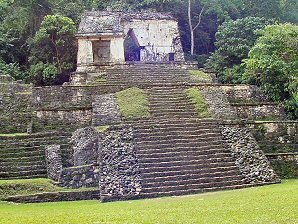

Temple 21
"Temple Of The Skull"
Also Known As
"Temple Of The Dying Moon" "Templo de la Calavera" Note The
Rabbit Skull Below The X 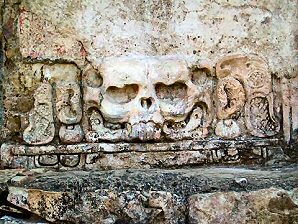
Close Up Of Rabbit Skull
Since The Dying Moon Is A Rabbit
This Could Be A Dying Moon Temple 13, On East Side
Of Temple 21.
Forground, Back Of
Grave Stone Of
Archaeologist
Albert Ruz Lhuillier. 
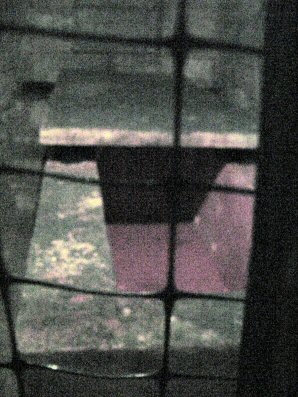
Inside Temple 13. Tomb Inside Temple 13. 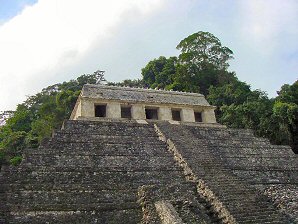
The "Temple Of The Inscriptions"
Note the height Of The People
For Scale. The "Temple Of The Inscriptions"
Upper Temple, Steep Steps. 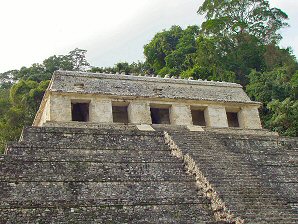
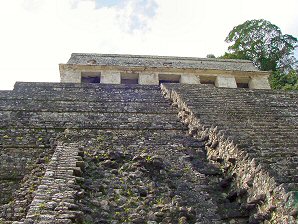
The "Temple Of
The Inscriptions"
Tunnel To Tomb,
Behind Left Column.
Just Left Of Central Door. The "Temple Of The Inscriptions"
Very Steep Climb Up The Steps. 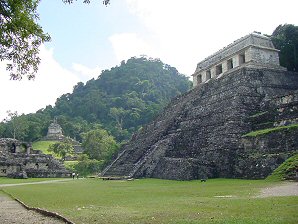
Altar In Front Of
The "Temple Of The Inscriptions". Trail Leading To The Cross Group.
"Temple Of The Cross".
In Background 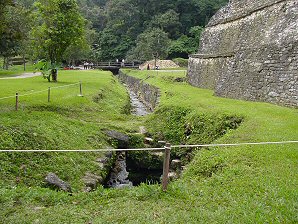
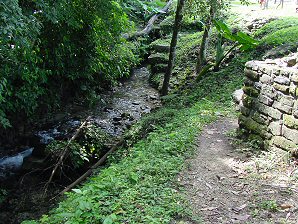
The Aqueduct
And Foot Bridge That
We Walk Over
To Cross Group.
TurnTo The Right
After The Bridge. The "Rio Otolum"
A Few Feet
East Of "The Palace". 
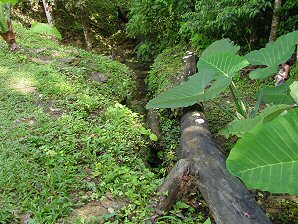
Rio Otolum. Rio Otolum.
We Are Proud Of Our SafeSurf Rating!
Send E-Mail to: George DeLange: [email protected]
Click On Any Of The Following Links By Amazon.Com
For Books Or Videos About Touring In Mexico. No Obligation!
Here Are Some Links To The Very Best & Most Popular Items Sold On Amazon.Com
To Learn More! Click The Links Below. No Obligation, Of Course!
Other Palenque Archaeological Site Pages!
Getting to Palenque can be somewhat of a challenge since no major airlines travel to Palenque. Here are our suggestions:
By air:
By land:
You have to take highway 190 coming from Tuxtla Gutierrez, which goes across Chiapas in a west to southeast direction going past San Crist�bal de las Casas, and then on highway 199 leading to Ocosingo and Palenque. The trip takes approximately 5 hours. If your drive begins at Villahermosa, you take highway 186 up to the City of Esc�rcega; from there you take highway 114 to the Municipality of Palenque, where there is a bifurcation towards the archaeological compound. The trip takes a little over two hours.
By train:
Also, you could take the "Mayan Express", a luxurious tourist service connecting M�rida and Palenque. The "Mayan Express" train has a coffee car, dinning car and club car. It also has a library specialised on pre-Hispanic cultures. We have always driven there from either Tuxtla Gutierrez or Villahermosa. We would fly to one of those cities and then rent a car to drive to Palenque. There are "guides" at the Gate into Palenque, if you wish to hire a "guide." Note: There are several nice hotels in the nearby city of Palenque. There is no reason why you could not visit the Palenque ruins over a two or three day time period. That way, you could "see it all"! We have links to Priceline on this page so you can find airlines and hotels that serve those areas.
|
 |  |
| Temple 21 "Temple Of The Skull" Also Known As "Temple Of The Dying Moon" | "Templo de la Calavera" Note The Rabbit Skull Below The X |
|---|---|
 | |
| Close Up Of Rabbit Skull Since The Dying Moon Is A Rabbit This Could Be A Dying Moon | Temple 13, On East Side Of Temple 21. Forground, Back Of Grave Stone Of Archaeologist Albert Ruz Lhuillier. |
 |  |
| Inside Temple 13. | Tomb Inside Temple 13. |
 | |
| The "Temple Of The Inscriptions" Note the height Of The People For Scale. | The "Temple Of The Inscriptions" Upper Temple, Steep Steps. |
 |  |
| The "Temple Of The Inscriptions" Tunnel To Tomb, Behind Left Column. Just Left Of Central Door. | The "Temple Of The Inscriptions" Very Steep Climb Up The Steps. |
 | |
| Altar In Front Of The "Temple Of The Inscriptions". | Trail Leading To The Cross Group. "Temple Of The Cross". In Background |
 |  |
| The Aqueduct And Foot Bridge That We Walk Over To Cross Group. TurnTo The Right After The Bridge. | The "Rio Otolum" A Few Feet East Of "The Palace". |
 |  |
| Rio Otolum. | Rio Otolum. |
We Are Proud Of Our SafeSurf Rating!
Click On Any Of The Following Links By Amazon.Com
For Books Or Videos About Touring In Mexico. No Obligation!
Here Are Some Links To The Very Best & Most Popular Items Sold On Amazon.Com
To Learn More! Click The Links Below. No Obligation, Of Course!
Other Palenque Archaeological Site Pages!



